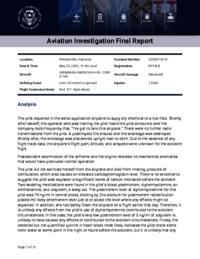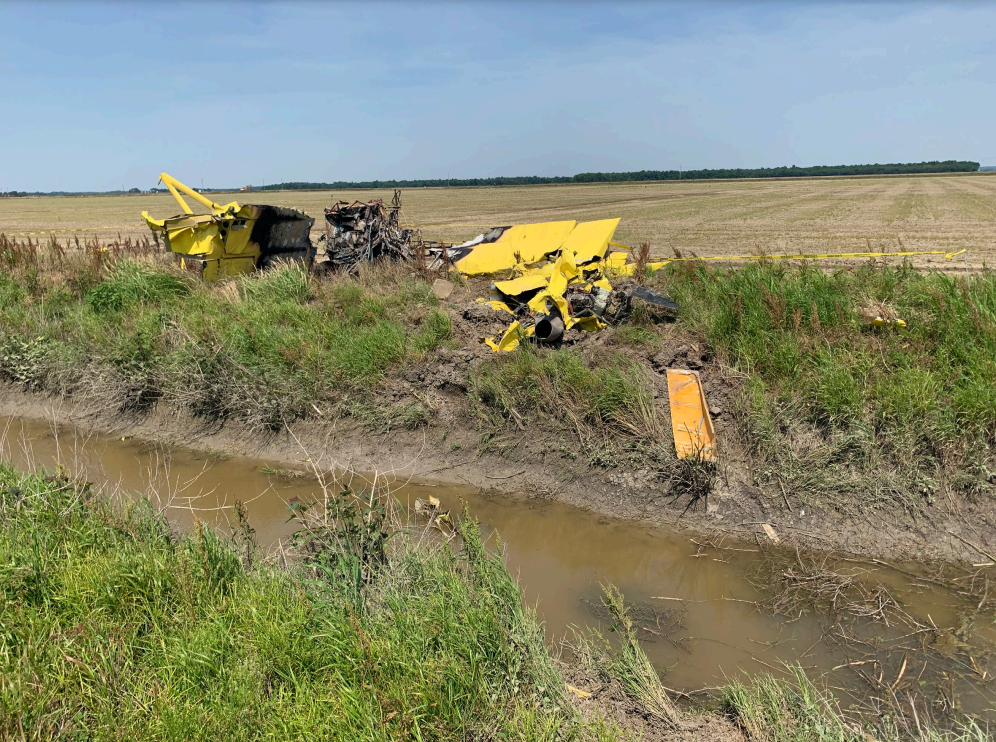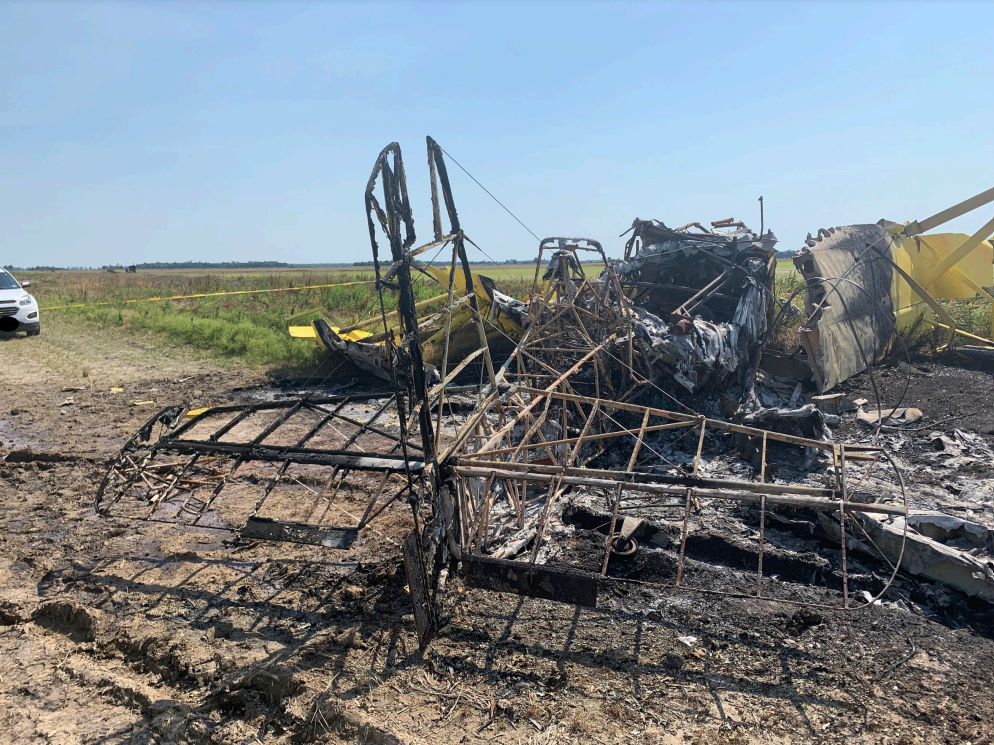
This information is added by users of ASN. Neither ASN nor the Flight Safety Foundation are responsible for the completeness or correctness of this information.
If you feel this information is incomplete or incorrect, you can submit corrected information.
| Date: | Saturday 28 May 2022 |
| Time: | 13:40 |
| Type: |  Grumman G-164B Ag-Cat |
| Owner/operator: | Hackberry Flying Service LLC |
| Registration: | N178LB |
| MSN: | 178B |
| Year of manufacture: | 1977 |
| Fatalities: | Fatalities: 1 / Occupants: 1 |
| Other fatalities: | 0 |
| Aircraft damage: | Destroyed |
| Category: | Accident |
| Location: | near Whiskerville, AR -
 United States of America United States of America
|
| Phase: | Landing |
| Nature: | Agricultural |
| Departure airport: | Beech Grove Airport, AR (private) |
| Beech Grove Airport, AR (private) | |
| Investigating agency: | NTSB |
| Confidence Rating: |
The pilot departed in the aerial application airplane to apply dry chemical to a rice field. Shortly after takeoff, the operator who was training the pilot heard the pilot announce over the company radio frequency that, “I’ve got to land this airplane.” There were no further radio transmissions from the pilot. A postimpact fire ensued and the wreckage was destroyed. Shortly after, the wreckage was discovered upright next to ditch. Due to the absence of any flight track data, the airplane’s flight path, altitude, and airspeed were unknown for the accident flight.
Postaccident examination of the airframe and the engine revealed no mechanical anomalies that would have precluded normal operation.
The pilot did not extricate herself from the airplane and died from inhaling products of combustion, which also caused an elevated carboxyhemoglobin level. There is no evidence to suggest the pilot was exposed to significant levels of carbon monoxide before the accident. Two sedating medications were found in the pilot’s blood postmortem, diphenhydramine, an antihistamine, and zolpidem, a sleep aid. The postmortem level of diphenhydramine for this pilot was 79 ng/ml in central blood; dividing by 3 to account for postmortem redistribution places the likely antemortem level just at or above the level where any effects might be expected. In addition, she had safely flown the airplane on a flight earlier that day. Therefore, it is unlikely any effects from the pilot’s use of diphenhydramine contributed to the accident circumstances. In this case, the pilot’s very low postmortem level of 3 ng/ml of zolpidem is unlikely to have caused any effects or contributed to the accident circumstances. Finally, the detected but not quantified quinine in heart blood most likely indicates the pilot drank some tonic water at some point in the night or hours before the accident, but it is unlikely that any effects from her use contributed to the accident circumstances. Overall, it is unlikely that any effects from the identified substances contributed to the accident circumstances.
The airplane’s fuel system ruptured during the accident sequence and a fire ensued, consuming the airplane. . The airplane was not equipped with, nor was it required to be equipped with, a crash-resistant fuel system. According to sources, a postimpact fire presents a significant risk of fire-related injuries to airplane occupants, and crash-resistant fuel systems reduce the risk of postimpact fire and can provide occupants with more time to escape or be rescued.
The pilot’s last radio transmission indicated that she likely intended to land the airplane; however, it could not be determined what the reason was for her wanting to land the airplane. There was no evidence that the pilot performed an emergency hopper dump procedure. Based on the available evidence, it is likely the pilot was attempting to perform an emergency landing to a rice field, but because of the full chemical load, she misjudged the approach to landing and impacted a ditch immediately after touchdown, which resulted in the substantial damage to the airplane and postimpact fire.
Probable Cause: The pilot misjudged the approach during the emergency landing, likely due to the full chemical load, and impacted a ditch, resulting in substantial damage and postimpact fire. Contributing to the pilot’s injuries was the lack of a crash-resistant fuel system in the airplane.
Accident investigation:
 |
|
Sources:
https://www.kait8.com/2022/05/28/plane-crash-lawrence-county/
https://data.ntsb.gov/Docket?ProjectID=105142
https://registry.faa.gov/AircraftInquiry/Search/NNumberResult?nNumberTxt=178LB
https://www.airport-data.com/images/aircraft/001/139/001139797.jpg (photo)
Location
Images:


Photos: NTSB
Media:
NTSB is investigating the May 28, 2022, crash of a Grumman G-164B near Whiskerville, Arkansas.
— NTSB Newsroom (@NTSB_Newsroom) May 28, 2022
Revision history:
| Date/time | Contributor | Updates |
|---|---|---|
| 28-May-2022 22:49 | Captain Adam | Added |
| 29-May-2022 06:28 | RobertMB | Updated [Aircraft type, Location, Phase, Nature, Source, Embed code, Damage, Narrative] |
| 29-May-2022 07:02 | harro | Updated [Aircraft type] |
| 31-May-2022 15:02 | Captain Adam | Updated [Registration, Cn, Operator, Location, Phase, Source, Narrative] |
| 02-Jun-2022 00:20 | johnwg | Updated [Time, Location, Source, Narrative] |
| 03-Jun-2022 23:34 | Captain Adam | Updated [Time, Location, Phase, Departure airport, Destination airport, Source, Narrative, Category] |
| 05-Jun-2022 15:40 | johnwg | Updated [Destination airport, Source] |
| 15-May-2024 18:47 | Captain Adam | Updated [Time, Phase, Departure airport, Destination airport, Source, Narrative, Accident report, Photo] |
| 15-May-2024 18:48 | Captain Adam | Updated [Photo] |
Corrections or additions? ... Edit this accident description
The Aviation Safety Network is an exclusive service provided by:


 ©2024 Flight Safety Foundation
©2024 Flight Safety Foundation